The Rolex Single Red Sea-Dweller aka SRSD is a super rare beast. In early 1967, Rolex produced around 40 pieces for the Aquanauts of the U.S. Navy SEALAB 3 experiment who for the first time in history were going to decent below the depth rating of a regular Rolex Submariner. For a series of circumstances, SEALAB 3 was delayed and in the meantime, it became clear that saturation diving was absolutely detrimental to regular diving watches. Made to withstand solely outside pressure, with saturation diving the watches had to cope with inside pressure as well when the divers decompressed to return to surface pressure. Helium from the special breathing gas got trapped inside the cases and wented off by bursting out the crystals. Today, the whereabouts of barely a dozen of the earliest Sea-Dwellers are known.
If you google Rolex Single Red Sea Dweller or Rolex Sea Dweller Prototype, you will inevitably come across a watch that is not what it pretends to be. Featured in May 2015 by Monochrome, a watch blog run by a Dutch named Frank Geelen, the article promoting an “ultra-rare prototype” somehow sneaked into Google’s top results and is sitting there like a big, fat and ugly bug. I researched the history of the Rolex Sea-Dweller to exhaustion and solved many of the riddles surrounding this reference. One of mysteries was the watch in question and I can say with 100% certainty it is a fake Single Red Sea-Dweller, pieced together from rare original parts to scam people. Geelen, who I personally reached out to in June 2020 to inform him and ask for the removal of said article, could not care less. Despite having been provided all the evidence needed, Geelen did not react.
Rolex Sea-Dweller, 1759659
The watch in question was once an asset in the portfolio of a watch hedge fund named Precious Time Fund which was established in 2010 by Elite Advisers in Luxembourg. According to information received, the watch surfaced in a pawn shop in Chicago, USA and found its way into the fund’s portfolio via an unnamed US dealer. Most if not all of the fund’s assets were valuated by a French watch dealer and expert named Romain Rea who in April 2017 became the CEO of Antiquorum.
On January 18, 2013, Precious Time posted the following picture on their Facebook page. The dial of this watch was undoubltedly an original Single Red dial but it had clearly seen better days. Of all the known Single Red Sea-Dwellers, the dial of this watch is the one in worst condition, probably as a result of a water damage.

Link to post: 1665 No Valve Single Red (Facebook)
According to the former fund manager of Precious Time, someone had pointed out that the case number was unusual for a Single Red Sea-Dweller but without offering a plausible explanation, the remark was simply ignored.
Most known Single Red Sea-Dwellers have case numbers between 1602000 and 1602040. Then there is a unique piece with case number 1820177 which belonged to Dr. Ralph W. Brauer, a leading hyperbaric researcher from the United States. Brauer’s watch was the very first Sea-Dweller prototype to ever feature a helium valve.
Case number-wise, the watch in question sits nicely between the earliest Sea-Dwellers from the 1.6 million range and Brauer’s 1.8 million watch. It could very well be that the watch was acquired assuming it was ok. It is not. Although the 1.7 million cases were produced in the fourth quarter of 1967, it was not until late 1970 that they were completed. More on this later.
In 2015, Precious Time got into trouble following the suspension of its sister wine fund Noble Crus. Too many investors reclaimed their money at once and the watch fund was liquidated. This is when the fake Single Red Sea-Dweller with case number 1759569 was inserted into the general market through a dealer from Luxembourg named Christian Bissener. To promote the sale, Monochrome published the controversial article which included the selling price of EUR 440,000 and a link to Christian Bissener’s website.
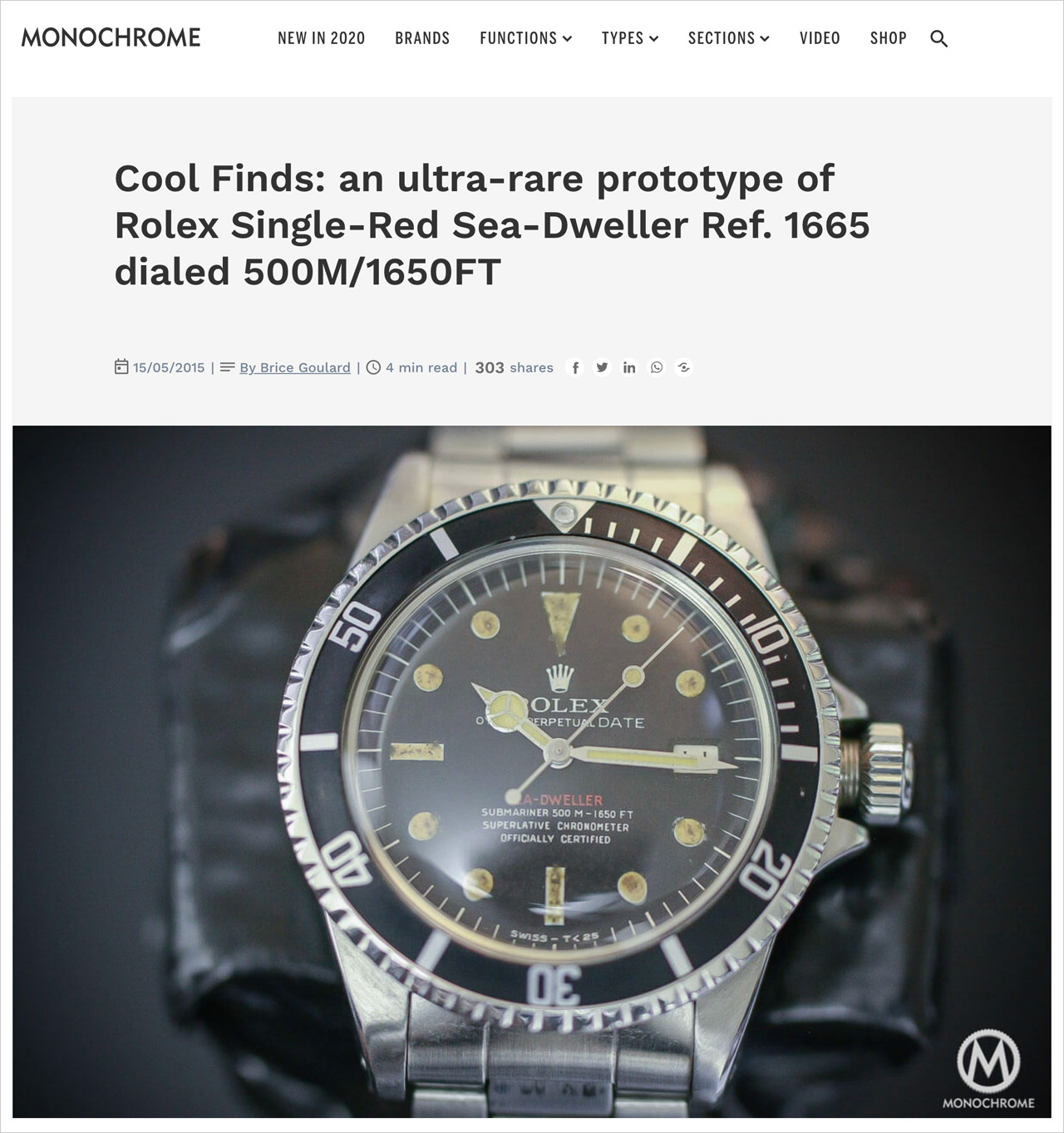
The article reads like a sales ad:
When it comes to collect rare watches – and especially Rolex watches – there are the classical ones, the rare ones and the others, the ones that you can find only once in a lifetime. This goes for an Albino Rolex Daytona (a.k.a the famous Clapton’s watch), a tropical coffee Paul Newman or a lemon dial Daytona Prototype. Those are the kind of watches that hardcore collectors are dreaming of – and even with the related bank account, there’s potentially no chance to get hands on them. Today, we found one of these ultra-rare birds, a one-of-six known, the Uber-rare prototype Rolex Single-Red Sea-Dweller Ref. 1665 dialed 500M/1650FT. And it’s for sale!
“It’s a once in a lifetime opportunity to acquire such an extremely rare watch – that can be seen as a holy Grail – a sort of untouchable myth. It’s for sale for € 440.000 Euros. If you’re interested, you can contact Christian Bissener from Watch Collector…”
Following this controversy, Frank Geelen deleted the original content and rewrote the article completely. More on this later. The original article can still be found here:
It is unclear whether the article succeeded at finding a buyer or not but two years later in May 2017, the same watch showed up at Antiquorum. The timing was quite interesting. The watch came up around one month after Romain Rea, the expert who valuated the piece for Precious Time, took over the reins of Antiquorum.
Auction link: Lot 544 – Rolex Ref 1665 – The Single Red Prototype – Patent Pending – 500M-1650FT – One Of Six Known (Antiquorum)
Watch collectors know a thing or two and were aware that this watch was outside the usual case number range for a Single Red Sea-Dweller. Luckily, Antiquorum was not able to unload this thing on some poor sap looking for an investment opportunity. The watch remained unsold. So far so good.
The same watch reappeared at an Antiquorum online auction in December 2018, this time with lots of pictures showing interesting details like the movement and the clasp. Since mid 2017, I had conducted a thorough investigation into the early models of the Rolex Sea-Dweller and I came to realize the caliber 1575 with movement serial number D829517 was not from 1967 but from much later.
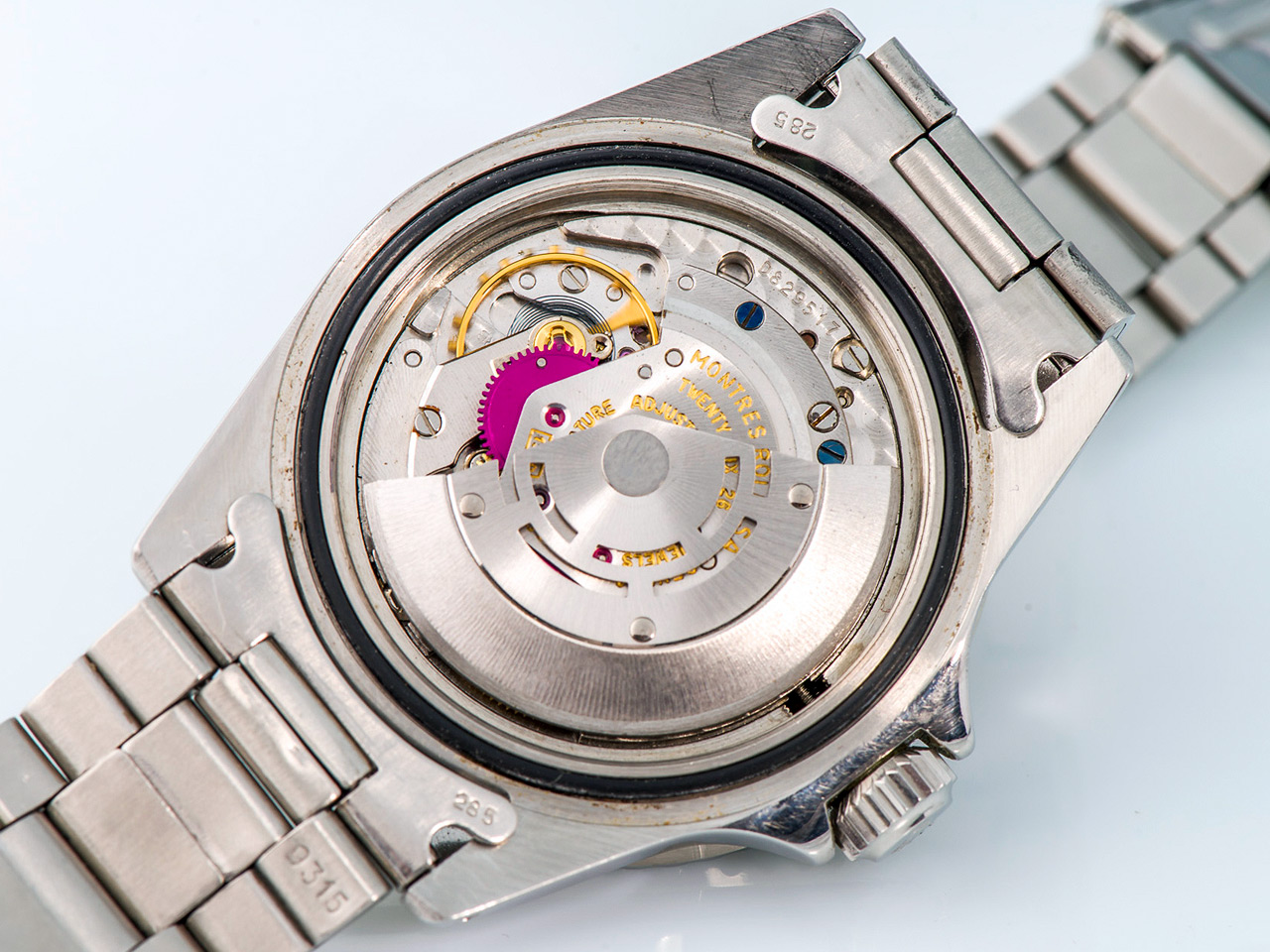
Although marked 1570, the calibers used for the first Sea-Dweller Ref. 1665 were actually caliber 1575 which was the date version of caliber 1570.
A close-up of the Single Red dial revealed a considerable amount of blisters all around the edge and in the area around the date window which are typical signs for a water damage. The dial condition did not match the rest of the watch, especially not that of the pristine 1575 caliber. In addition, the hands had an unnatural patina and looked like they had been repainted.
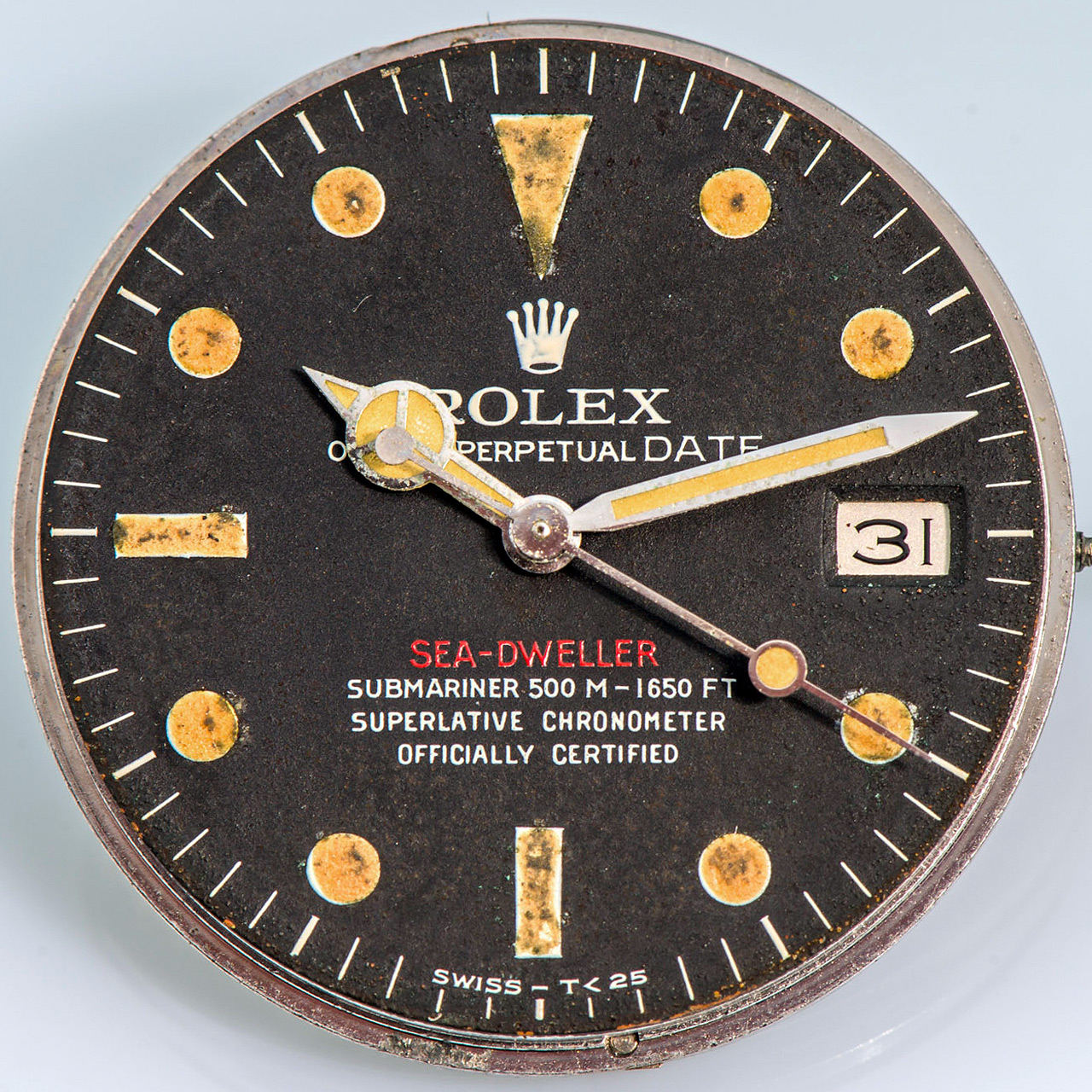
The movement main plate underneath the dial showed slight surface corrosion which is quite common and completely unrelated to water damage. This is regular contact corrosion that occured between the plated brass of the movement main plate and the stainless steel of the case. Tool marks can been seen as well. This type of corrosion can be found on Rolex Sea-Dwellers with perfectly well-preserved dials.
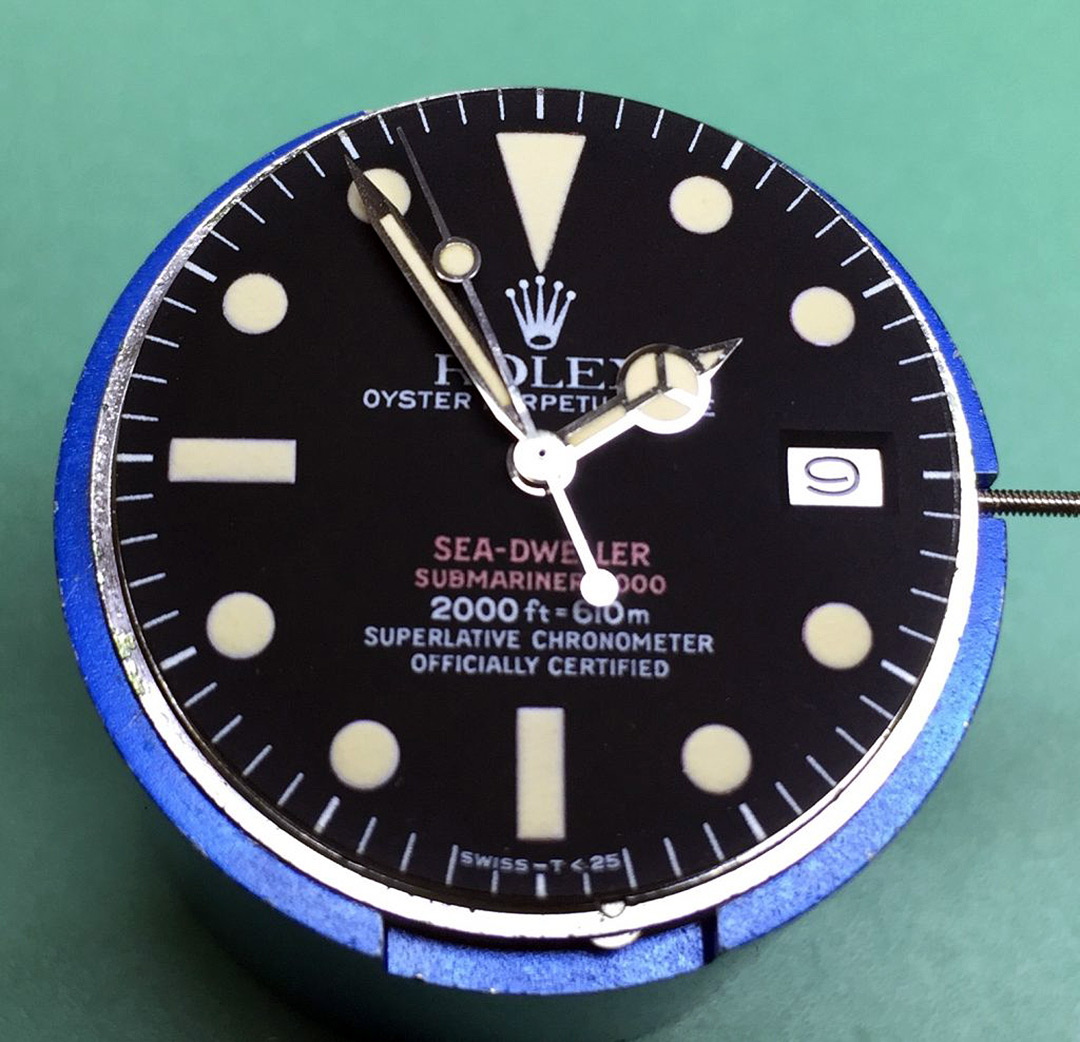
Another detail that did not add up was the Pat. Pend. (Patent Pending) diver extension on a clasp which bore the date stamp 4-71, indicating a production in the fourth quarter of 1971. This combination is unheard of.
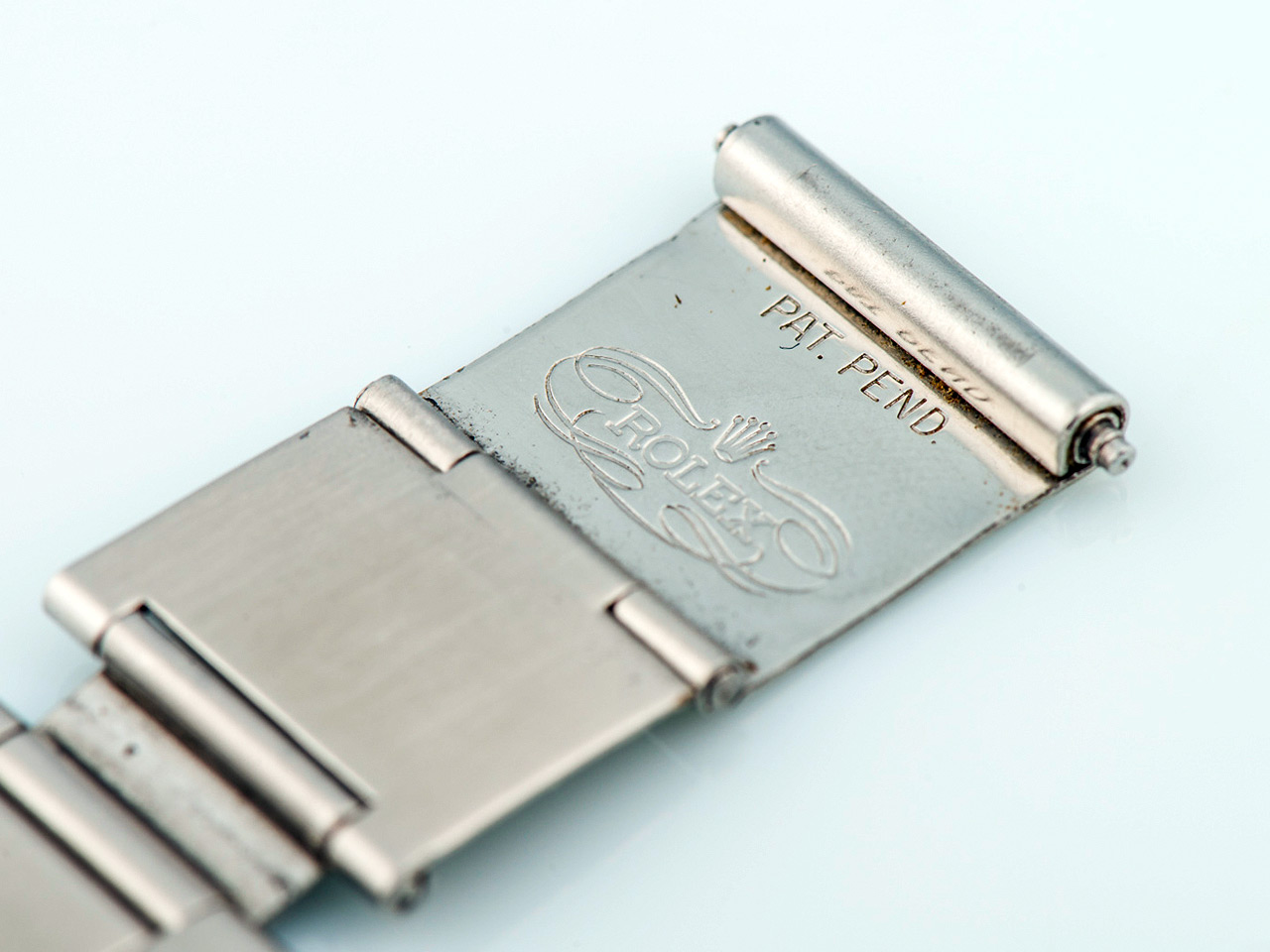
The patent for the diver extension belonged to the Swiss bracelet manufacturer Gay Frères and was granted in July 1970 (US3521331). Once the patent was obtained, Gay Frères stopped applying the Pat. Pend. designation. All clasps with diver extension made from the third quarter of 1970 (3-70) onwards bore the misspelled designation Pateted (Patented). The bracelet in question is not original in this configuation and was pieced together to support the prototype story.
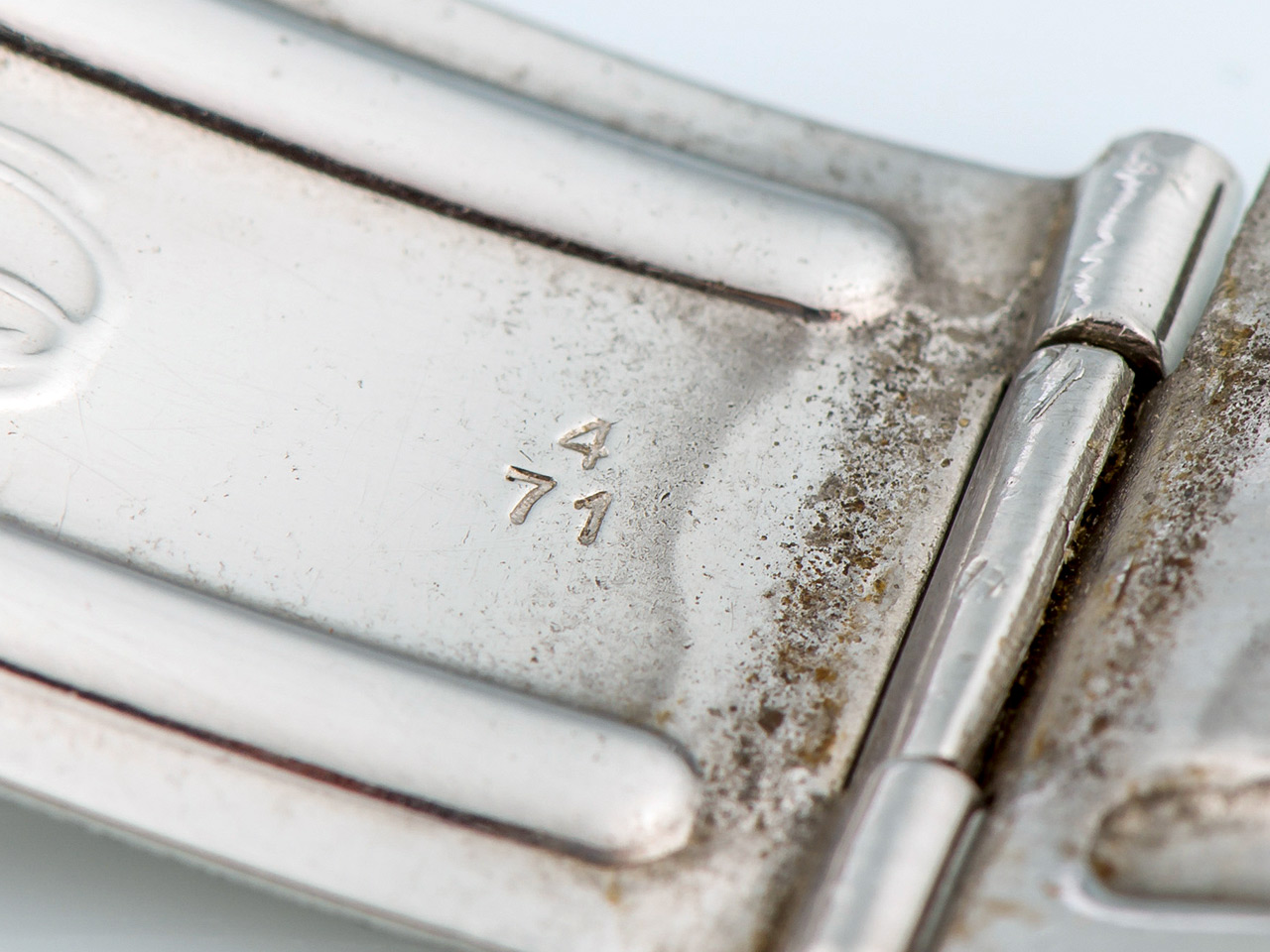
Link to patent: Clasp for a metallic bracelet (Google Patents)
At the time, the watch seemed like it had been pieced together from loose parts. Prior to the auction, I published an article to warn about the fake Single Red Sea-Dweller and other problematic pieces. This was already the third or fourth article I felt compelled to write in 2018 to point out issues with a variety of watches coming up at Antiquorum. After my first Antiquorum exposure which took place in late March 2018, something very interesting happened. Instagram trolls speaking on Antiquorum’s behalf started attacking me. These hostilities soon turned into vicious attempts at criminal defamation and character assasination and continued all throughout 2018 and 2019. I did not follow the December 2018 auction but it appears the fake Single Red Sea-Dweller sold despite my warnings. The trolls took to Instagram and declared victory. My opinions, so their claim, had zero weight in the vintage watch world.
As mentioned earlier, Monochrome deleted the original article following this exposé. Instead of apologizing to the watch community for their mistake, Frank Geelen rewrote the article as an attack on me, calling me a Panerai faker and using the same dirty methods and false accusations as the Antiquorum trolls in 2018/19.
Read more: Caution! More fake and made-up stuff from Antiquorum
A few days later, Antiquorum made the following Instagram post to celebrate the sale of Lot 274. At the time, HKD 3,400,00 were the equivalent of around USD 435,000. Quite a sum for a fake prototype.
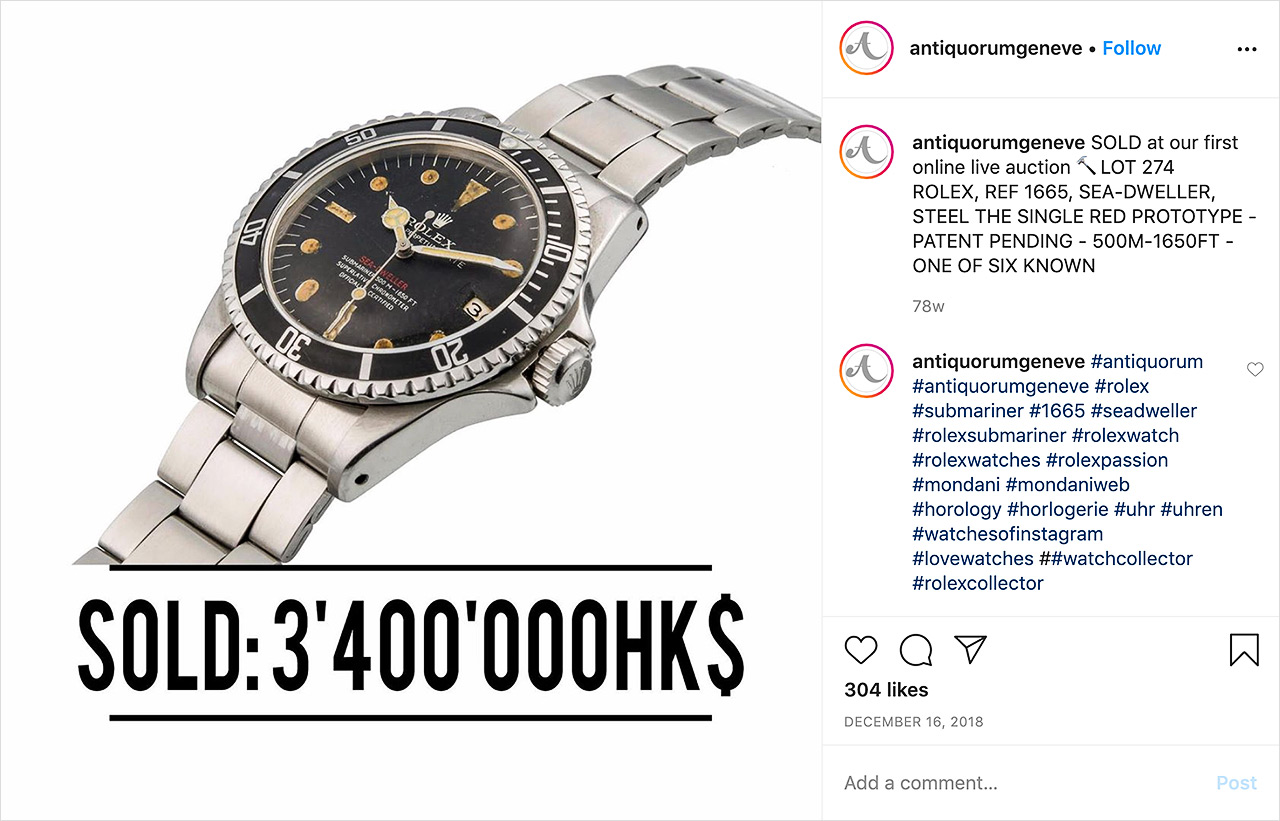
Link to post: Sold at out first online live auction – Lot 274 (Instagram)
Interestingly, the listing on the Antiquorum website never stated the watch as sold. Today, Lot 274 has disappeared from the auction overview page and the listing cannot be found by typing the case number into the search box. The listing itself, however, is still accessible through a direct link.
Auction link: Lot 274 – Rolex, Ref 1665, Sea-Dweller, Steel, The Single Red Prototype (Antiquorum)
Was the watch sold? Either it was sold and the buyer retracted from the deal after becoming aware what the watch was all about, or, the whole thing was a sham from the very beginning and the bids were not real.
Why The Watch Is Not Ok
Sea-Dwellers from the 1.7 million case number range were assembled and retrofitted with a valve from late 1970 onwards, at a time when Rolex case numbers had already reached 2.6 million. What sounds illogical at first, is a fact proven not only by movement serial numbers but also by other important details like later Double Red dials (DRSD) and casebacks referring to the patented gas escape valve (after June 1970) as opposed to the pending patent (Patent Pending). Some of these watches remained valve-less, meaning the valve was not retrofitted. The reason for this pecularity is unknown but the movement serial numbers of these watches are evidence they are by no means early prototypes as often claimed.
The watch in question is without a doubt one of these valve-less Sea-Dwellers from late 1970 and there is absolutely no way it left the Rolex factory with a prototype Single Red dial from 1967. The numerous blisters and the distinct “runny” lume on the dial tell the story. Here is what happened. When one of the Single Red Sea-Dwellers from the 1.6 million case number range suffered a water damage, the dial was replaced. A perfect example for this is Philippe Cousteau’s early Sea-Dweller with Double Red Mk1 dial. Somehow, the water damaged dial ended up with a true genius of a watch dealer who thought it would be a good idea to marry a valve-less Sea-Dweller with the Single Red dial to create the illusion of an early prototype. The made-up bracelet was thrown in to reinforce the grift. A closer look at the timeline makes all of the above crystal-clear.
1967
The very first 40 Rolex Sea-Dwellers featured Single Red dials and bore 1.6 million case numbers. They were produced between April and June 1967. The production period is documented on the inside of the casebacks with the date stamp II.67 (second quarter 1967). These watches were merely Uber Submariners with an increased depth rating of 1650ft/500m. At the time of production, Rolex had not yet received the idea for the helium release valve. These early examples were made for the U.S. Navy SEALAB 3 experiment that was scheduled for October 1967. Once manufactured, the 40 watches were imported to the United States via Rolex USA in New York to be handed out to the American Aquanauts. Due to the complexity of the experiment, however, SEALAB 3 was postponed for one year.

Nevertheless, Rolex started the serial production of the Sea-Dweller in early fall 1967. The casebacks were stamped IV.67 (fourth quarter 1967). In mid October 1967, an archeological diver named T. Walker Lloyd approached Rolex with information the Genevean company had never heard of. During decompression from prolonged saturation dives of 14 and more days (e.g. SEALAB 2), diving watches were apt to explode due to helium built-up on the inside of the cases. Mr. Lloyd became aware of the issues through SEALAB Aquanaut Bob Barth who had already suggested a simple yet brilliant remedy for this problem. A one-way helium valve.
Rolex director André Heiniger was so captivated by Mr. Lloyd, he immediately hired him as an Oceanographic Consultant. On November 6, 1967, Rolex filed a patent application with the Swiss Patent Office to secure the idea.
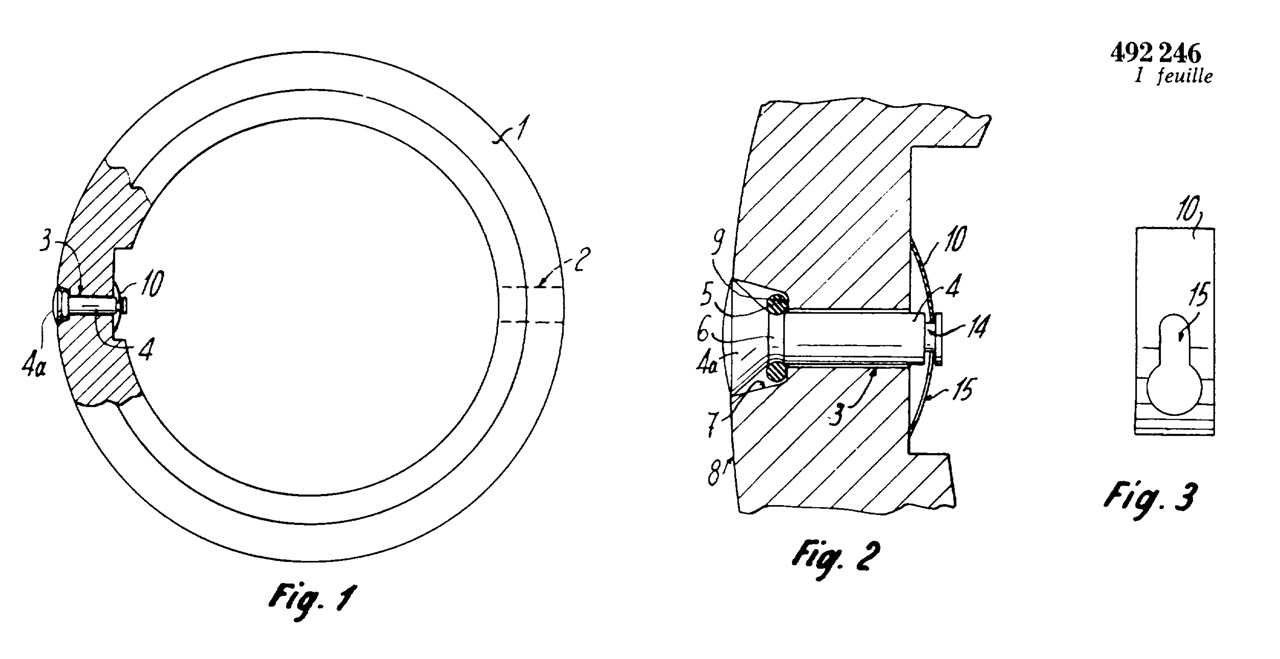
As described in the patent, helium does not enter a watch quickly. It takes several days of exposure to a pressurized helium atmosphere.
En effet, on a constaté que, quelles que soient les qualités d’étachéité des boîtes de montres réalisées jusqu’a ce jour, lorsqu’elles sont soumis pendant des durées relativement longues, de l’ordre de plusieurs centaines d’heures, à des pressions relativement fortes, de l’ordre des plusieurs dizaines d’atmostphères, et specialment lorsque l’atmosphère ambiente est faite d’un gaz à molécules de petite dimensions, comme c’est le cas de l’hélium par example, qu’on utilise fréquemment dans les cloches de plongée, la pression à l’intérieur de la boîte finit par s’équilibrer avec la pression ambiente.
Translation: In fact, it has been observed that, whatever the qualities of the watertightness of the watch cases produced to date, when they are subjected for relatively long periods, on a scale of several hundred hours, to relatively strong pressures, on a scale of several tens of atmospheres, and especially when the ambient atmosphere is made of a gas with small molecules, as is the case with helium for example, that frequently used in diving bells, the pressure inside the box eventually equilibrates with the ambient pressure.
Link to patent: Montre étanche (CH492246)
Since SEALAB 3 had been postponed to late 1968, there was no immediate chance to test the valve under real life conditions and the project was procrastinated. The following table lists the most important characteristics of the 40 initial Rolex Single Red Sea-Dwellers from the very first batch.
Rolex Single Red Sea-Dweller Ref. 1665
| Assembled | Case number | Dial | Helium Valve | Caseback | Cal. serial |
|---|---|---|---|---|---|
| Q2 1967 | 1602913 | SRSD | No | II.67 | D73158 |
| Q2 1967 | 160291X | SRSD | No | II.67 | 6414X |
| Q2 1967 | 16029XX | SRSD | No | II.67 | D69XXX |
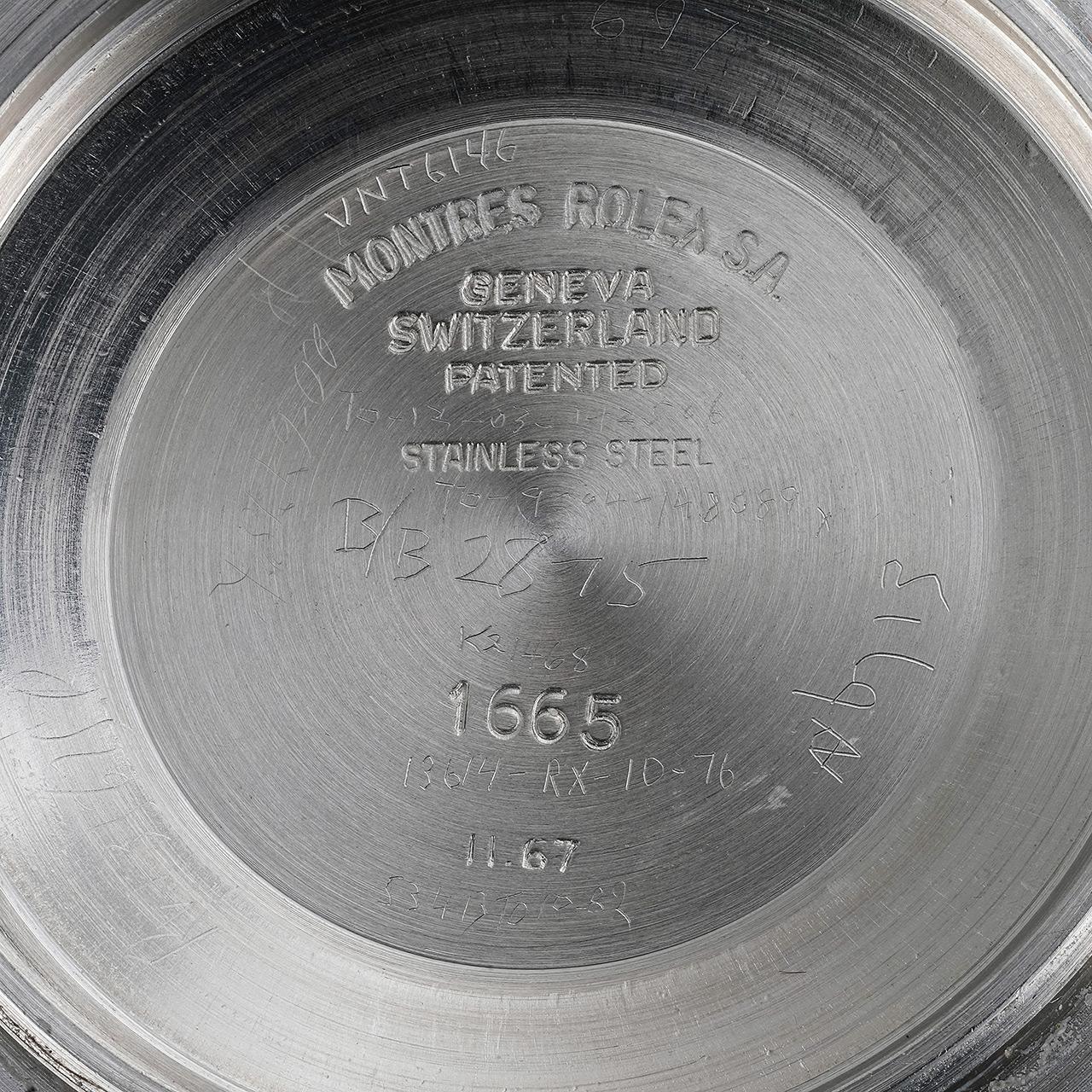
1968
In early March 1968, an emerging French diving firm named Comex (Compangie Maritime d’Expertises) made the news when they set a depth record of 1100ft/335m in a pressure chamber in Marseille, France. This achievement was made possible thanks to the pioneering work of Dr. Ralph Werner Brauer, a German born American physiologist and leading hyperbaric researcher who had carried out the experiments on himself. Brauer was a daredevil. An even more daring experiment named Hydra was planned for May 1968. Brauer himself would descend below 1000ft/300m in the open sea to test a new gas mixture consisiting of highly explosive hydrogen gas.
Rolex wanted to get on board but competitor Omega had already partnered up with Comex. Their goal? To create the ultimate saturation dive watch, the so-called Ploprof (Plongeur Professionnel = professional diver). The U.S. Navy was no longer the benchmark in saturation diving but private companies like Comex with endless funds from the oil industry and the willingness to take greater risks. Suddenly, Rolex saw themselves under massive pressure as they had already lost the race to space against Omega and needed to succeed in this new race to the inner space if they wanted to stay relevant.
Since Dr. Brauer was a professor at the University of North Carolina and therefore not bound to Comex’s contract with Omega, Rolex approached him while he was in Marseille and gave him the very first Sea-Dweller valve-prototype for testing in the upcoming dives. Brauer’s watch featured the very same Single Red Sea-Dweller dial as the first Sea-Dweller batch from the 1.6 million case number range but since it had been manufactured in early 1968, its case number was 1820177. While Brauer’s watch worked flawlessly, the testing was not conclusive as the watch was never exposed to helium for several hundreds of hours as it would have been the case in a underwater habitat like SEALAB 3.
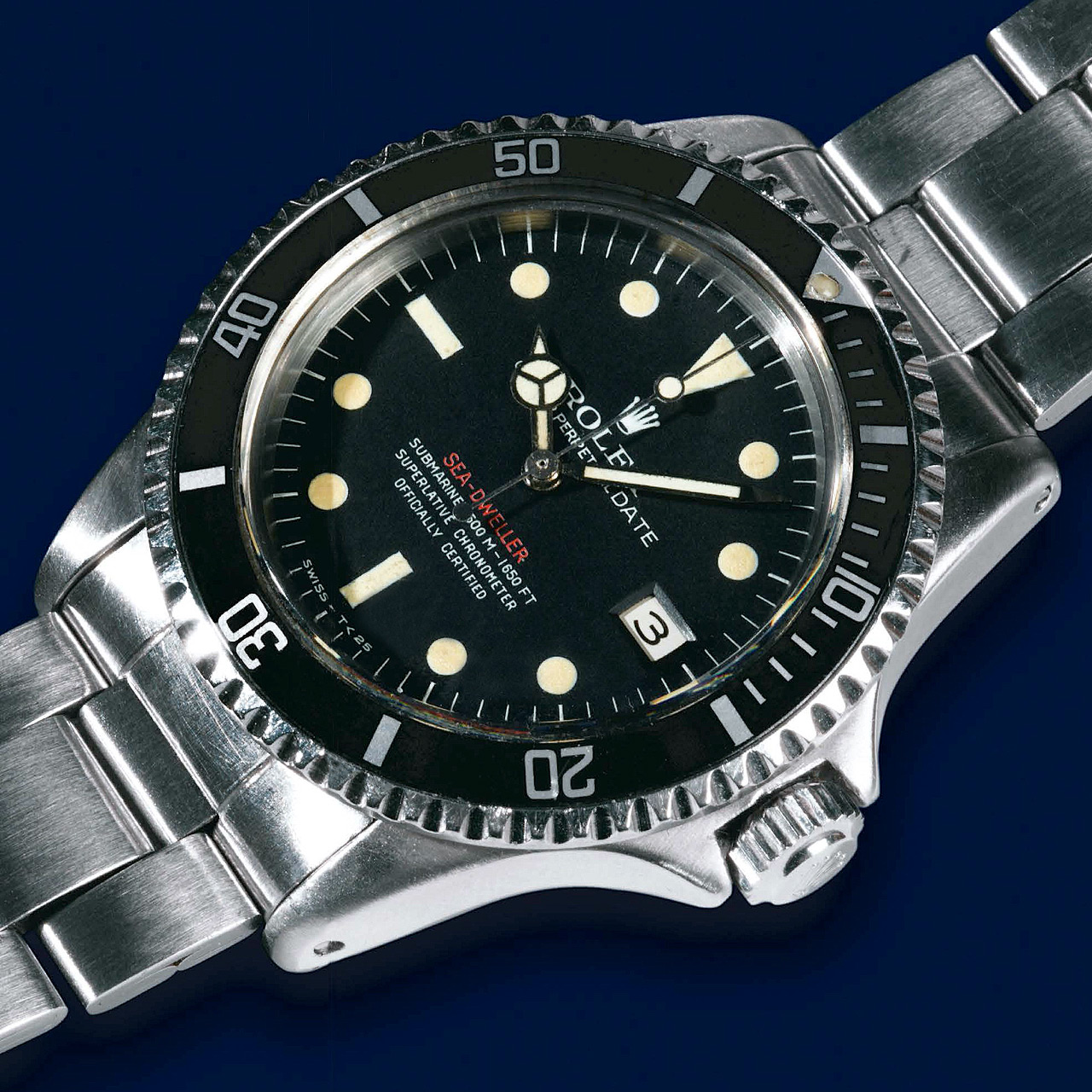
Compared to the 1.6 and 1.7 million cases, Brauer’s watch has a slightly thicker case to comfortably accomodate the valve. While its movement serial number matches those of the first Sea-Dweller batch, the caseback features the date stamp IV.67 as Rolex used one from the 1.7 million case production which had started in late 1967. 1820177 is a case number from 1968. Other Rolex models (e.g. Ref. 1675) from the 1.8 million case number range have casebacks with I.68 date stamp. An important detail of Dr. Brauer’s watch is the hand-applied Oyster Gas Escape Valve – Patent Pending designation on its caseback.

Rolex Single Red Sea-Dweller Dr. Brauer Ref. 1665
| Assembled | Case number | Dial | Helium Valve | Caseback | Cal. serial |
|---|---|---|---|---|---|
| Q1 1968 | 1820177 | SRSD | Yes | IV.67 (PP) | D69043 |
Read more: The Sea-Dweller Chronicles: Genesis of the Decompressing Watch
In fall 1968, Rolex USA retrofitted the helium valve to some of the 40 Single Red Sea-Dwellers from the 1.6 million case number range that had been sitting in New York since mid 1967. Subsequently, these watches were presented to SEALAB 3 Aquanauts to be tested during the upcoming experiment in a depth 600ft/182m. Due to a series of technical failures, however, SEALAB 3 was again postponed and could only take place in mid February 1969. During the set up of the habitat after it had been lowered to the bottom, Aquanaut Berry L. Cannon died as a result of a faulty breathing apparatus and the experiment was abandoned. Once again, Rolex was denied a proper testing.
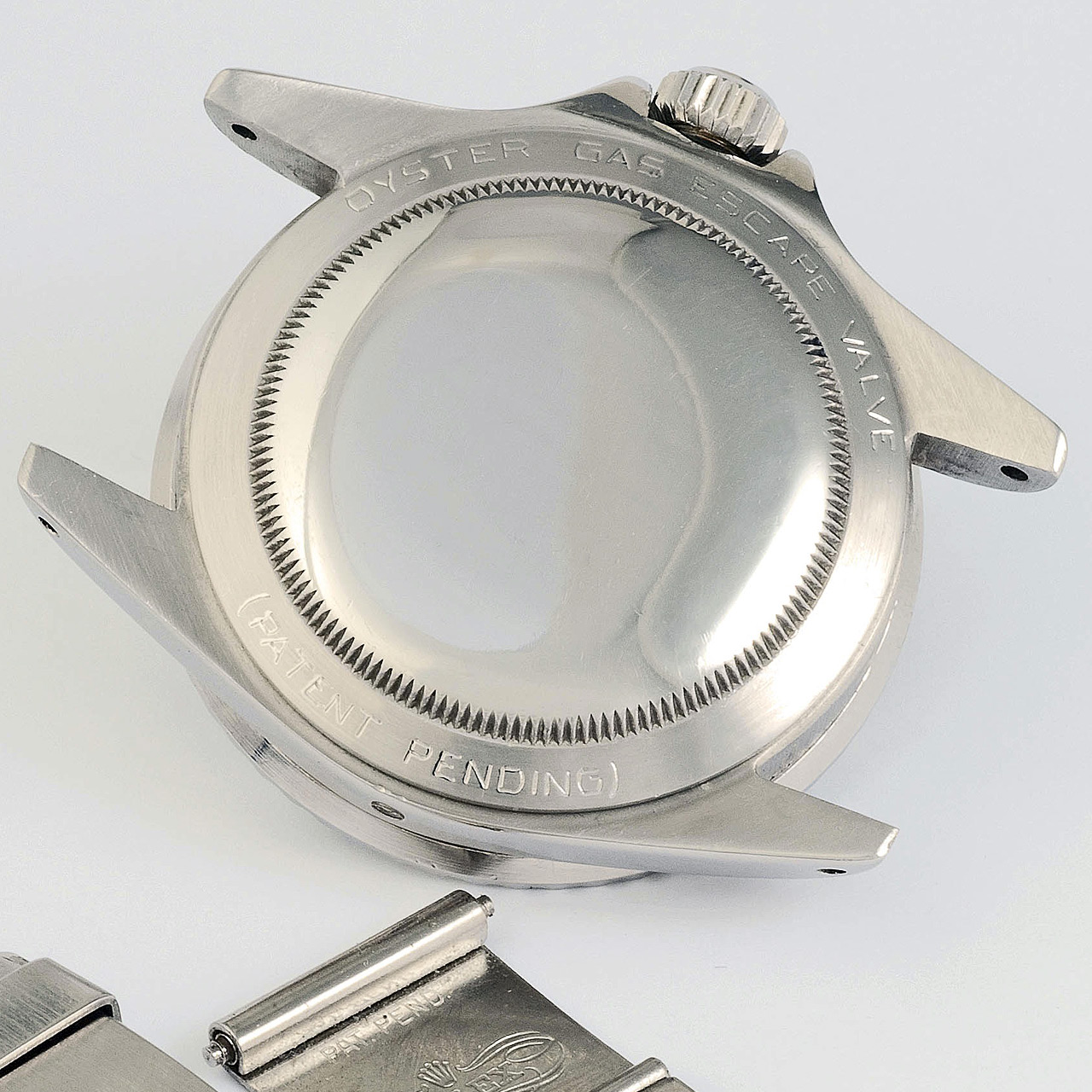
1.6 million Sea-Dwellers with a retrofitted valve have similar characteristics as non-valve watches, except for a later caseback with date stamp IV.67 and Patent Pending engravings on the outside.
Rolex Single Red Sea-Dweller With Retrofitted Valve Ref. 1665
| Assembled | Case number | Dial | Helium Valve | Caseback | Cal. serial |
|---|---|---|---|---|---|
| mod. Q3/4 1968 | 160291X | SRSD | Yes (retrofitted) | IV.67 (PP) | D72XXX |
| mod. Q3/4 1968 | 1602922 | SRSD | Yes (retrofitted) | IV.67 (PP) | D71617 |
| mod. Q3/4 1968 | 1602931 | SRSD | Yes (retrofitted) | IV.67 (PP) | D69145 |
1969
All throughout 1967/68 and independently from SEALAB 3, the U.S. Navy had developed a sophisticated Deep Diving System (DDC). Although SEALAB 3 had ended in a disaster, saturation diving itself was now fully established. With the DDC in place, the divers were no longer required to live in an underwater habitat at the dark bottom of the sea where they had to cook their own meals, etc. Now, the divers could live and sleep during the whole duration of their mission aboard a diving support vessel in a comfortable Deck Decompression Chamber (DDC). To do the actual work at depth, the men were lowered to the bottom in a pressurized Personnel Transfer Capsule (PTC) and returned to their safe surface habitat after finishing their shift.
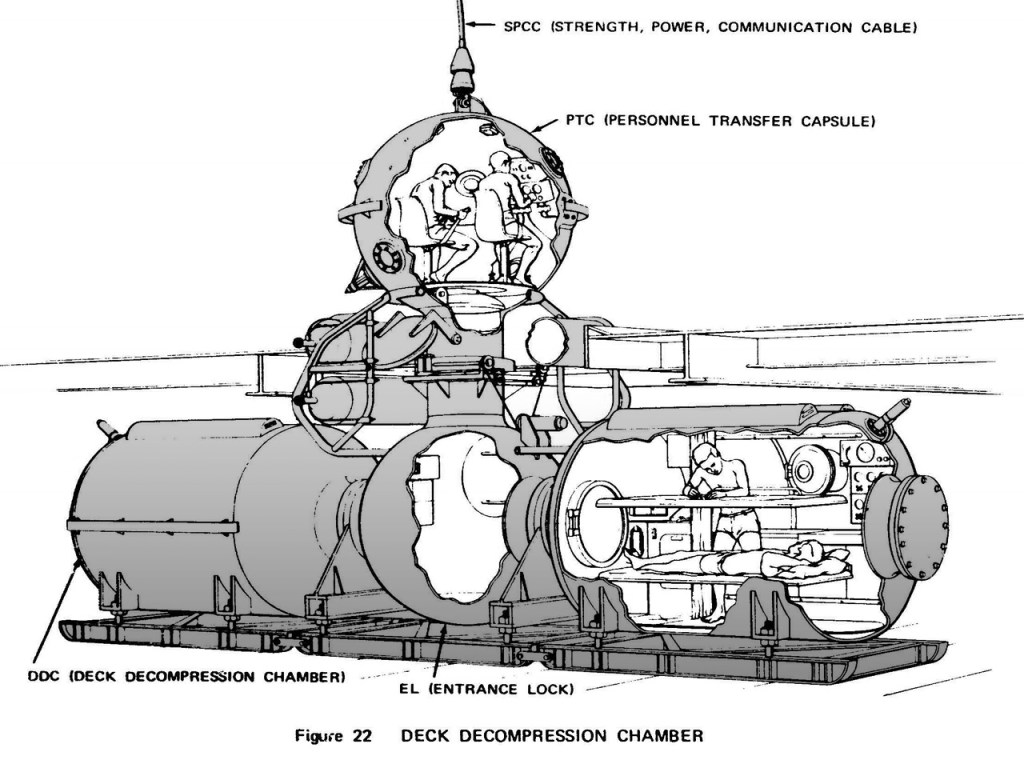
In 1969, Rolex produced 300 new Sea-Dweller prototypes (in three batches of 100) based on Brauer’s slightly thicker prototype. The depth rating was increased 2000ft/610m to compete with Omega’s upcoming Seamaster 600 Ploprof. Many of these watches were presented to U.S. Navy divers to obtain more conclusive test results. The new dial featured now two lines of red writing and is known among collectors as Double Red (DRSD). Since the patent for the valve was still in process, the caseback bore the remark Patent Pending.
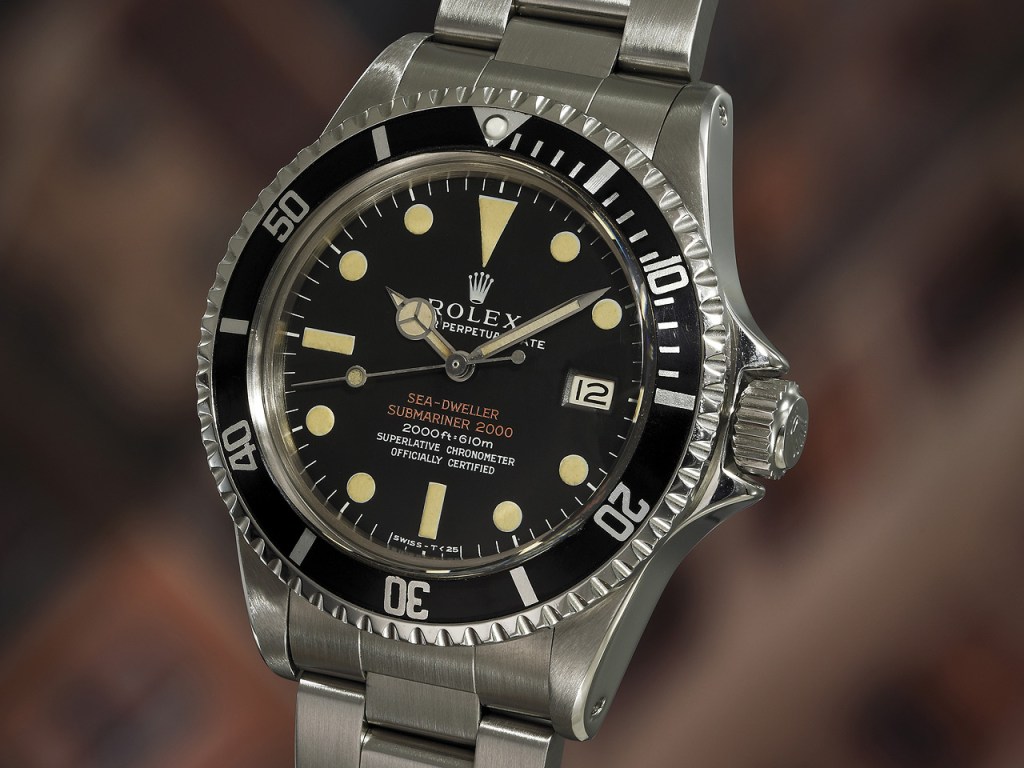
The first two batches were made in the second quarter of 1969. Although the case number range is slightly different, both batches were assembled in one go as suggested by the very similar movement serial numbers. The date stamp on the casebacks is IV.67 which often leads enthusiasts and even auction houses to believe these watches were made in 1967. The reason for this discrepancy is simple. Rolex produced a large number of casebacks in late 1967 and used them for all batches up to the 2.9 million case number range. Other Rolex models with similar case numbers, e.g. Ref. 1680, have casebacks with date stamp II.69 (second quarter of 1969).
First batch Rolex Double Red Sea-Dweller Ref. 1665
| Assembled | Case number | Dial | Helium Valve | Caseback | Cal. serial |
|---|---|---|---|---|---|
| Q2 1969 | 2117410 | DRSD Mk 1 | Yes | IV.67 (PP) | D397445 |
| Q2 1969 | 2117471 | DRSD Mk 1 | Yes | IV.67 (PP) | D362707 |
| Q2 1969 | 2117475 | DRSD Mk 1 | Yes | IV.67 (PP) | D394669 |
Second ROLEX DOUBLE RED SEA-DWELLER batch Ref. 1665
| Assembled | Case number | Dial | Helium Valve | Caseback | Cal. serial |
|---|---|---|---|---|---|
| Q2 1969 | 2128245 | DRSD Mk 1 | Yes | IV.67 (PP) | D390518 |
| Q2 1969 | 2128269 | DRSD Mk 1 | Yes | IV.67 (PP) | D363266 |
| Q2 1969 | 2128275 | DRSD Mk 1 | Yes | IV.67 (PP) | D377731 |
An easy way to determine the production period of the above listed Sea-Dweller batches is to compare the watches to other Rolex models that featured the same movements. In 1969, Rolex launched the production of a new Rolex Submariner model with date complication that is known among collectors as Red Submariner Date Ref. 1680. This model was equipped with the very same Cal. 1575 as the Sea-Dweller Ref. 1665. The Cal. 1575 was the date version of Cal. 1570. Interestingly, there are Ref. 1680 watches with very similar case numbers as the two aforementioned Sea-Dweller siblings. The movement serial numbers are almost identical as well. The casebacks of these Submariner Date models bear the date stamp II.69 (second quarter of 1969).
| Assembled | Case number | Dial | Caseback | Cal. serial |
|---|---|---|---|---|
| Q2 1969 | 2104638 | Red Mk 1 | II.69 | D362378 |
| Q2 1969 | 21XXXXX | Red Mk 1 | II.69 | D378773 |
| Q2 1969 | 2154167 | Red Mk 1 | II.69 | D361740 |
Third batch ROLEX DOUBLE RED SEA-DWELLER Ref. 1665
| Assembled | Case number | Dial | Helium Valve | Caseback | cal. serial |
|---|---|---|---|---|---|
| Q3 1969 | 2247966 | DRSD Mk 2 | Yes | IV.67 (PP) | D548691 |
| Q3 1969 | 2247986 | DRSD Mk 2 | Yes | IV.67 (PP) | D547409 |
| Q3 1969 | 2247995 | DRSD Mk 2 | Yes | IV.67 (PP) | D549761 |
A comparison of the third Double Red Sea-Dweller batch with Red Submariner Date Ref. 1680 models made in the second half of 1969 shows they have slightly lower movement serial numbers.
| Assembled | Case number | Dial | Caseback | CAL. SERIAL |
|---|---|---|---|---|
| Q3 1969 | 2241069 | Red Mk 2 | III.69 | D510507 |
| Q3 1969 | 2241098 | Red Mk 1 | III.69 | D423325 |
| Q3 1969 | 2241171 | Red Mk 2 | III.69 | D432752 |
1970
In 1970, Rolex continued to hand out Double Red Sea-Dweller prototypes from the 1969 production to U.S. Navy divers for testing purposes. One particular test was of special importance. It took place on June 22, 1970 at the Navy Experimental Diving Unit (NEDU) in Washington DC and resulted in an exposure to a helium atmosphere for a total of 28 days. The Swiss Patent Office had just granted Rolex the patent for the helium release valve (CH492246) on June 15, 1970 and the Sea-Dweller was now ready to be introduced to the general public. The earliest advertisements were published in mid November 1970 in the United States. Rolex had still a number of unused prototypes from the 1969 production and loaned them to professional divers in return for test reports. Around the same time, Rolex manufactured the 2.6 million Sea-Dwellers and retrofitted the valve to the 1.7 million cases that had been lying around since late 1967.
Read more: The Sea-Dweller Chronicles: Dry Run and Teaming Up with Comex
2.6 million Rolex Double Red SEA-DWELLER Ref. 1665
| Assembled | Case number | Dial | Helium Valve | Caseback | Cal. serial |
|---|---|---|---|---|---|
| Q4 1970 | 2665630 | DRSD Mk 2 | Yes | IV.67 (P) | D804035 |
| Q4 1970 | 2665650 | DRSD Mk 2 | Yes | IV.67 (P) | D832967 |
| Q4 1970 | 2665706 | DRSD Mk 2 | Yes | IV.67 (P) | D837993 |
A comparison of the movement serial numbers from 2.6 million batch with the serial numbers of the 1.7 million Sea-Dwellers without valve shows that the numbers are in close proximity. There can be no doubt these watches were assembled in the same period of time.
1.7 million Non-Valve ROLEX SEA-DWELLER Ref. 1665
| Assembled | Case number | Dial | Helium Valve | Caseback | Cal. serial |
|---|---|---|---|---|---|
| Q4 1970 | 1719767 | DRSD Mk1 | No | IV.67 | D803643 |
| Q4 1970 | 1719770 | DRSD Mk0 | No | IV.67 | n.a. |
| Q4 1970 | 1719785 | DRSD Mk1 | No | IV.67 | D831617 |
| Q4 1970 | 1719786 | Red Sub Mk1 | No | IV.67 | D796549 |
| Q4 1970 | 1719787 | DRSD Mk1 | No | IV.67 | D233564 (repl.) |
| Q4 1970 | 1721685 | DRSD Mk2 | No | IV.67 | D834144 |
| Q4 1970 | 1759659 | SRSD | No | IV.67 | D829517 |
| Q4 1970 | 1759666 | DRSD Mk1 | No | IV.67 | D82XXXX |
It interesting to note that these non-valve Sea-Dwellers are inconsistent among each other when it comes to their dials. From a production point of view this makes little sense. Given the period of assembly it is likely that most of these watches were altered in the past 20 years to create the illusion of early prototypes. The only example which in my opinion remained untouched with its original DRSD Mk2 dial is 1721685, a watch that was sold on November 19, 1971. Only the DRSD Mk2 dial is period correct for this type of watch.
Auction link: Rolex Sea-Dweller, No Valve, Double Red, 1721685 (Kaplans Auctioneer)
A comparison with Rolex Red Submariner Date Ref. 1680 models from the 2.6 million range shows the movement numbers are again very similar. The date stamp on these watches is IV.70 (fourth quarter of 1970).
| Assembled | Case number | Dial | Caseback | Cal. serial |
|---|---|---|---|---|
| Q4 1970 | 2636209 | Red Mk4 | IV.70 | D777765 |
| Q4 1970 | 269XXXX | Red Mk4 | IV.70 | D837490 |
| Q4 1970 | 2694546 | Red Mk4 | IV.70 | D831610 |
Some 1.7 million Sea-Dwellers featuring a retrofitted valve have slightly higher movement serial numbers which is an indication they were assembled in the first half of 1971 and later.
1.7 million Valve ROLEX SEA-DWELLER Ref. 1665
| Assembled | Case number | Dial | Helium Valve | Caseback | Cal. serial |
|---|---|---|---|---|---|
| Q1 1971 | 1719764 | DRSD Mk2 | Yes (retrofitted) | IV.67 (P) | D999902 |
| Q1 1971 | 1758323 | DRSD Mk2 | Yes (retrofitted) | IV.67 (P) | D986520 |
| Q1 1971 | 1760323 | DRSD Mk2 | Yes (retrofitted) | IV.67 (P) | D991828 |
The table below lists characteristic Sea-Dwellers from each batch made until early 1972 in their correct chronology. This overview makes visible how once the helium valve patent was granted in June 1970, Rolex changed the caseback designation from Patent Pending (PP) to Patented (P).
| Assembled | Case number | Dial | Helium valve | Caseback | Cal. serial |
|---|---|---|---|---|---|
| Q2 1967 | 1602913 | SRSD | No | II.67 | D73158 (ROW) |
| Q1 1968 | 1820177 | SRSD | Yes | IV.67 (PP) | D69043 |
| mod. Q3 1968 | 1602922 | SRSD | Yes (retrofitted) | IV.67 (PP) | D71617 (ROW) |
| Q2 1969 | 2117410 | DRSD Mk1 | Yes | IV.67 (PP) | D397445 |
| Q2 1969 | 2128245 | DRSD Mk1 | Yes | IV.67 (PP) | D390518 |
| Q3 1969 | 2247966 | DRSD Mk2 | Yes | IV.67 (PP) | D548691 |
| June 15, 1970 | Patent granted | ||||
| Q4 1970 | 2665650 | DRSD Mk 2 | Yes | IV.67 (P) | D832967 |
| Q4 1970 | 1721685 | DRSD Mk2 | No | IV.67 | D834144 |
| Q1 1971 | 1758323 | DRSD Mk2 | Yes (retrofitted) | IV.67 (P) | D986520 |
| Q3 1971 | 2926856 | DRSD Mk2 | Yes | IV.67 (P) | D013067 |
| Q1 1972 | 30663XX | DRSD Mk2 | Yes | I.72 (P) | D2023XX |
The movement serial numbers of Cal. 1570/75 reached 1 million in the third quarter of 1971 and started over from zero. Movements made after the reset are easy identifiable by their slightly redesigned balance cock. Some Sea-Dwellers made between 1967 and 1972 feature movement serial numbers that differ from the above listed range. In such cases it can be assumed the movements were replaced or the watches were assembled after 1971. In early 1972, Rolex created a new version of the Sea-Dweller with a thicker case but the reference number 1665 remained the same. These new models bore the data stamp I.72 (first quarter of 1972).
Thoughts
This case illustrates beautifully how most of the mainstream watch media outlets operate these days. Watch blogs like Monochrome are more focussed on developing profitable relationships with watch brands and dealers than on providing well-researched and critical content for their readers. Disguised as independent news outlets run by enthusiasts, these blogs are nothing but leasable megaphones for the watch industry. The readers are secondary in this scheme, mere numbers – often blown up – something to brag about in the presence of marketing directors.
When I reached out to Frank Geelen to ask for the removal of their misleading article, he said he knows “shit about old Rolex” and that he wants to keep it that way. Judging by the content he has produced so far, it certainly appears like his knowledge in this field is extremely limited. In March 2017 for instance, Geelen wrote an article for The Hour Glass in which he claimed the helium release valve was developed in collaboration with Comex and that the Rolex 5514 made for Comex – a model produced from 1974 onwards – was the prototype for the Sea-Dweller. Both these claims are utter and complete nonsense and were debunked long time ago. The million-dollar question is, why does Geelen keep littering the internet with his dubious and highly inaccurate content?
In regard of the fake Single Red Sea-Dweller article, Geelen admited: “The seller told me the story as it is in the article.” What a journalistic masterpiece indeed! These blogs have zero sense of responsibility towards readers and could not care less whether the published information is correct or not. The article reads like a sales ad and certainly smells like paid content but Geelen denies having been remunerated. That is not how he works, he said. To this day, the article is still online and no caveats were added even though Geelen received all of the above information a long time ago. It is pretty clear who Geelen’s loyalty belongs to.
Thank you for your interest.
History Of The Rolex Sea-Dweller
The development of the Rolex Sea-Dweller goes hand in hand with man’s persistence to push the boundries and reach never before thought possible depths. The following infographic shows the evolution of the Sea-Dweller in its historical context.

This graphic is available as a high quality print in two sizes:
- Regular small, 120cm x 68cm (47 x 26 inch): EUR 85.00 (plus shipping)
- Regular, 150cm x 85cm (59 x 33 inch): EUR 120.00 (plus shipping)
Limited: 50 pieces, numbered and signed by Bob Barth, the legendary US Navy Aquanaut who pioneered saturation diving during the famous SEALAB missions. Bob developed the idea for the Rolex Gas Escape Valve: Sold out
To order a poster, please shoot me a DM on Instagram: @perezcope

As always – great article Jose, Greetings Pale_ora/Tom
LikeLike
Fantastic article. I came here by chance and in fact own a Rolex (though by comparison it’s an uninteresting oyster perpetual) and began at the top and found myself captivated, reading all the way to the bottom. Well researched and presented. I’m not surprised to hear about fraudulence activities on the internet, it abounds in such quantity that we would all be amazed by the truth of it. Speaking of truth thank, you for presenting it here.
LikeLike
People online are truly, very often, complete children. They focus(ed) on your opinions and “how they carry no weight,” and yet a pure Frankenstein was sold right in front of them. Talk about missing the point.
LikeLike
Great article! Please go ahed with your professional investigations, which have already enlightened so many fake watches and fake narrations. Since the truth has few allies these days, your stories are as valuable as exceptional.
LikeLike
What a fabulous article. You are so right in terms of the journalistic qualities of so many of the blogs, vlogs and articles. For the most part I think a lot of the inaccuracies are down to a lack of research, and the need to get things out quickly to meet deadlines.
There is also so much being made of the vintage market now as the prices have gone crazy, a little bit like the classic car market of the late 90’s.
It is a fascinating story that has been out together around that watch, and I love the level of research that has gone into pointing out all the facts. I think you are doing a great job of highlighting the potential risks right across the industry.
From my side, I would only have one question, which is surely Rolex would want to clear this up. Given the evidence and the research, and also the fact that the Rolex archives should have every fact and detail on record.
Anyway.. Just my thoughts… And what a great piece.
LikeLike
Very interesting article, particularly about Mr Geelen. I have had a run in with him on his article “Face to Face – Rolex Submariner 116610LN vs Omega Seamaster Diver 300M” dated 31 Jul 20. In his article he claimed that the Rolex movement was built to an “industry standard” to resist at least 100 Gauss of magnetism without the need for a soft iron shield. This is, as far as I can tell complete fiction. He used that point to justify why the Submariner was a superior watch. When I called him out on the matter and pointed out that Rolex themselves make no such claim for their movements and asking him to publish the “industry standard” to which Rolex worked he banned me from Monochrome watches website.
LikeLike
Super article! The info also serves as a true Northstar for evaluating early DRSD’s…
Some of your statements got me slightly puzzled: I have a DRSD Mk2 in 1,7 mio valve-case and a caseback with corresponding last 3 digits but IV.68 stamp and a 1570 movement with nr. D98439. Two questions: do you know of any IV.68 casebacks? and: why is my movement nr D followed by only 5 digits?
LikeLike
Thank you for your feedback. Interesting, I’ve never seen a IV.68 caseback. Could you please send detail pictures of your watch to jose at myurl dot com?
LikeLike
Superb article. I found that on a DRSD MK IV dial I recently checked, there is some red stuff around the markers just like the dial photo in this article. Is that normal and due to corrosion?
LikeLike
Geelen and Brice are both pretentious clowns
LikeLike